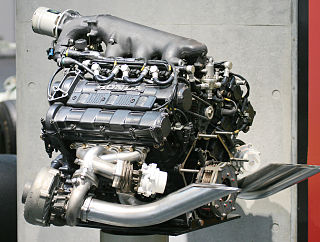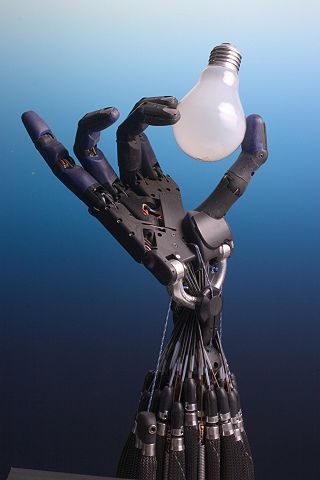Related Research Articles

An android is a humanoid robot or other artificial being often made from a flesh-like material. Historically, androids were completely within the domain of science fiction and frequently seen in film and television, but advances in robot technology now allow the design of functional and realistic humanoid robots.

Electrical engineering is an engineering discipline concerned with the study, design, and application of equipment, devices, and systems which use electricity, electronics, and electromagnetism. It emerged as an identifiable occupation in the latter half of the 19th century after the commercialization of the electric telegraph, the telephone, and electrical power generation, distribution, and use.

Kevin Warwick is an English engineer and Deputy Vice-Chancellor (Research) at Coventry University. He is known for his studies on direct interfaces between computer systems and the human nervous system, and has also done research concerning robotics.

Mechanical engineering is the study of physical machines that may involve force and movement. It is an engineering branch that combines engineering physics and mathematics principles with materials science, to design, analyze, manufacture, and maintain mechanical systems. It is one of the oldest and broadest of the engineering branches.

A robot is a machine—especially one programmable by a computer—capable of carrying out a complex series of actions automatically. A robot can be guided by an external control device, or the control may be embedded within. Robots may be constructed to evoke human form, but most robots are task-performing machines, designed with an emphasis on stark functionality, rather than expressive aesthetics.

In philosophy, systems theory, science, and art, emergence occurs when a complex entity has properties or behaviors that its parts do not have on their own, and emerge only when they interact in a wider whole.

A machine is a physical system that uses power to apply forces and control movement to perform an action. The term is commonly applied to artificial devices, such as those employing engines or motors, but also to natural biological macromolecules, such as molecular machines. Machines can be driven by animals and people, by natural forces such as wind and water, and by chemical, thermal, or electrical power, and include a system of mechanisms that shape the actuator input to achieve a specific application of output forces and movement. They can also include computers and sensors that monitor performance and plan movement, often called mechanical systems.

An industrial robot is a robot system used for manufacturing. Industrial robots are automated, programmable and capable of movement on three or more axes.

A factory, manufacturing plant or a production plant is an industrial facility, often a complex consisting of several buildings filled with machinery, where workers manufacture items or operate machines which process each item into another. They are a critical part of modern economic production, with the majority of the world's goods being created or processed within factories.

Machine vision (MV) is the technology and methods used to provide imaging-based automatic inspection and analysis for such applications as automatic inspection, process control, and robot guidance, usually in industry. Machine vision refers to many technologies, software and hardware products, integrated systems, actions, methods and expertise. Machine vision as a systems engineering discipline can be considered distinct from computer vision, a form of computer science. It attempts to integrate existing technologies in new ways and apply them to solve real world problems. The term is the prevalent one for these functions in industrial automation environments but is also used for these functions in other environment vehicle guidance.

Automation describes a wide range of technologies that reduce human intervention in processes, mainly by predetermining decision criteria, subprocess relationships, and related actions, as well as embodying those predeterminations in machines. Automation has been achieved by various means including mechanical, hydraulic, pneumatic, electrical, electronic devices, and computers, usually in combination. Complicated systems, such as modern factories, airplanes, and ships typically use combinations of all of these techniques. The benefit of automation includes labor savings, reducing waste, savings in electricity costs, savings in material costs, and improvements to quality, accuracy, and precision.
In mechanical and control engineering, a servomechanism is a control system for the position and its time derivatives, such as velocity, of a mechanical system. It often includes a servomotor, and uses closed-loop control to reduce steady-state error and improve dynamic response. In closed-loop control, error-sensing negative feedback is used to correct the action of the mechanism. In displacement-controlled applications, it usually includes a built-in encoder or other position feedback mechanism to ensure the output is achieving the desired effect. Following a specified motion trajectory is called servoing, where "servo" is used as a verb. The servo prefix originates from the Latin word servus meaning slave.

Survival Research Laboratories (SRL) is an American performance art group that pioneered the genre of large-scale machine performance. Founded in 1978 by Mark Pauline in San Francisco, the group is known in particular for their performances where custom-built machines, often robotic, compete to destroy each other. The performances, described by one critic as "noisy, violent and destructive", are noted for the visual and aural cacophony created by the often dangerous interactions of the machinery. SRL's work is also related to process art and generative art.

A kill switch, also known more formally as an emergency brake, emergency stop (E-stop), emergency off (EMO), or emergency power off (EPO), is a safety mechanism used to shut off machinery in an emergency, when it cannot be shut down in the usual manner. Unlike a normal shut-down switch or shut-down procedure, which shuts down all systems in order and turns off the machine without damage, a kill switch is designed and configured to abort the operation as quickly as possible and to be operated simply and quickly. Kill switches are usually designed to be noticeable, even to an untrained operator or a bystander.

FANUC is a Japanese group of companies that provide automation products and services such as robotics and computer numerical control wireless systems. These companies are principally FANUC Corporation of Japan, Fanuc America Corporation of Rochester Hills, Michigan, USA, and FANUC Europe Corporation S.A. of Luxembourg.

A servomotor is a rotary or linear actuator that allows for precise control of angular or linear position, velocity, and acceleration in a mechanical system. It constitutes part of a servomechanism, and consists of a suitable motor coupled to a sensor for position feedback. It also requires a relatively sophisticated controller, often a dedicated module designed specifically for use with servomotors.

A mobile robot is an automatic machine that is capable of locomotion. Mobile robotics is usually considered to be a subfield of robotics and information engineering.

The history of robots has its origins in the ancient world. During the industrial revolution, humans developed the structural engineering capability to control electricity so that machines could be powered with small motors. In the early 20th century, the notion of a humanoid machine was developed.

Robotics is the branch of technology that deals with the design, construction, operation, structural disposition, manufacture and application of robots. Robotics is related to the sciences of electronics, engineering, mechanics, and software.

Robotics is the interdisciplinary study and practice of the design, construction, operation, and use of robots.
References
- 1 2 3 Hunt, V. Daniel (1983). Industrial robotics handbook (2. print. ed.). New York, N.Y.: Industrial Press. p. 392. ISBN 9780831111489 . Retrieved 25 July 2012.
bang bang robot.
- ↑ M.D. Singh; J.G. Joshi (2006). Mechatronics. Delhi: Prentice-Hall of India. p. 422. ISBN 9788120329867 . Retrieved 25 July 2012.
- ↑ Angelo, Joseph (2006). Robotics : a reference guide to the new technology. Westport, CT: Greenwood Press. p. 117. ISBN 9781573563376 . Retrieved 25 July 2012.
- ↑ Hunt, V.D. (1983). Industrial Robotics Handbook . Industrial Press. p. 392. ISBN 9780831111489 . Retrieved 13 April 2015.